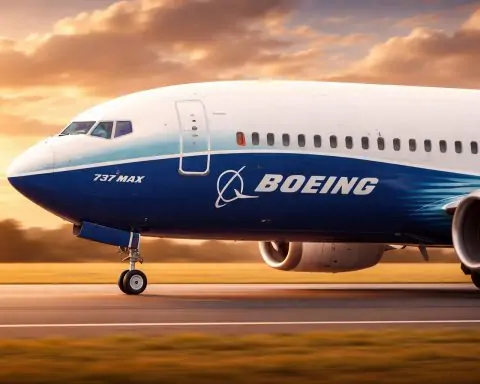Boeing Company (The) stock ended the shortened post‑Thanksgiving session higher on Friday, as investors weighed fresh multi‑billion‑dollar defense contracts and strong order activity against ongoing space, safety and profitability risks.
As of the close on Friday, November 28, 2025, Boeing (NYSE: BA) finished at $189.00 per share, up about 1.1% on the day. [1]
The move came in a broader risk‑on session that saw all three major U.S. indices advance, with the S&P 500 logging both weekly and monthly gains. [2]
Boeing Stock Price Snapshot for November 28, 2025
At today’s close, key figures for Boeing stock were: [3]
- Closing price: $189.00
- Daily move: +$2.08 (+1.11%)
- Intraday range: roughly $186.9 – $189.8
- Recent volume: ~3.7 million shares, below the 10‑day average, reflecting the holiday‑shortened session
- Market capitalization: about $144 billion
- 52‑week range:$128.88 – $242.69
At $189, Boeing trades about 22% below its 52‑week high, but still roughly 47% above its 52‑week low, underscoring how volatile the name has been through 2025. [4]
Because the company remains loss‑making on a trailing 12‑month basis, Boeing’s price‑to‑earnings ratio is negative (around –14), highlighting that the current valuation is based on expectations of a multi‑year recovery rather than normalized earnings today. [5]
What’s Driving Boeing Shares This Week?
Today’s move doesn’t exist in a vacuum. Boeing stock has been whipsawed in November by a mix of positive contract wins, new order momentum, legal and space‑program headlines, and lingering anxiety around execution.
1. $7+ Billion in New U.S. Defense Contracts
Earlier this week, the Pentagon disclosed that Boeing had secured more than $7 billion in new U.S. military contracts: [6]
- A nearly $4.7 billion U.S. Army contract to supply AH‑64E Apache attack helicopters, crew trainers and related equipment, including 96 Apaches for Poland under a foreign military sales deal. Deliveries are expected to begin in 2028, giving Boeing long‑dated revenue visibility and strengthening its position in the attack helicopter market. [7]
- An additional roughly $2.4 billion U.S. Air Force contract (Lot 12) for 15 KC‑46A Pegasus aerial refueling tankers and associated services, bringing the KC‑46A program to 183 aircraft under contract globally. [8]
Defense‑oriented investors took notice. MarketBeat today flagged Boeing among the “top defense stocks to watch”, alongside GE Aerospace, Lockheed Martin, Rocket Lab and RTX, citing sustained global demand for military aviation and missile defense. [9]
These wins bolster Boeing’s Defense, Space & Security segment, which already generated about $6.9 billion in Q3 revenue and returned to profitability at the operating level. [10]
2. NASA’s Starliner Contract Cut: A Negative Counterweight
The good news in defense has been partially offset by a high‑profile setback in space. On November 24, NASA announced it was reducing the number of flights in Boeing’s Starliner contract, cutting the total from six to four and lowering the contract’s value by about $768 million, from $4.5 billion to $3.732 billion. [11]
Key elements of the revised plan include: [12]
- The next Starliner mission in 2026 will be uncrewed, focused on cargo rather than astronauts.
- Only up to three astronaut flights are now envisaged under the current contract, instead of the six originally planned.
- NASA explicitly cited the spacecraft’s “bumpy” development history, including thruster problems that extended the first crewed test mission, leaving two astronauts on the International Space Station for nine months.
While NASA continues to say it wants two U.S. providers for ISS access, SpaceX’s Dragon remains the primary workhorse, and the Starliner downsizing raises questions about Boeing’s long‑term commercial role in low‑Earth orbit. The program has already cost Boeing more than $2 billion in charges, separate from NASA’s payments. [13]
For shareholders, the revised contract is a sentiment headwind: it chips away at a potential long‑term revenue stream and underscores how execution risk in space still weighs on the broader investment case.
3. Labor Peace – at a Higher Cost
Another important development this month is the end of a three‑month strike at several of Boeing’s key defense plants in the U.S. Midwest. On November 13, approximately 3,200 machinists who build fighter jets, weapons systems and the Navy’s first carrier‑based unmanned aircraft voted to approve a new five‑year contract, securing: [14]
- A 24% wage increase over the life of the deal
- A $6,000 signing bonus
The strike had threatened to slow production just as Boeing tries to regain its financial footing and ramp up defense output. Its resolution is a clear operational positive, but the higher labor costs will pressure margins over time, especially in fixed‑price defense programs where cost overruns can be punishing. [15]
4. Commercial Orders and a Busy Dubai Airshow
On the commercial side, Boeing’s order book has been busy through November, especially around the 2025 Dubai Airshow: [16]
- Emirates ordered 65 additional 777X jets, taking its total 777X commitments to 270 and reaffirming confidence in Boeing’s next‑generation widebody despite certification delays.
- Gulf Air finalized an order for 15 more 787 Dreamliners.
- flydubai signed an MoU for 75 737 MAX jets, with options for 75 more.
- Air Senegal, Ethiopian Airlines, Air Astana, Somon Air and Uzbekistan Airways all announced new or expanded 737 MAX and 787 deals.
Separately, Boeing highlighted that airlines across Central Asia have agreed to purchase up to 37 jets, strengthening U.S. trade ties and underpinning long‑term demand in a fast‑growing region. [17]
Taken together, these announcements reinforce one of the core pillars of the bull case: Boeing’s commercial backlog and the global demand for modern narrow‑ and wide‑body aircraft remain very strong.
Fundamentals After Q3 2025: Recovery with Caveats
Boeing’s latest quarterly report, released on October 29, 2025, painted a picture of improving operations but still‑steep losses. [18]
Revenue and Cash Flow
For Q3 2025, Boeing reported: [19]
- Revenue of $23.3 billion, up 30% year‑over‑year, driven by higher commercial aircraft deliveries and growth in all three business segments.
- 160 commercial aircraft deliveries in the quarter — the highest quarterly total since 2018 — and 440 deliveries year‑to‑date through September 30, up sharply from 291 in the same period of 2024. [20]
- Operating cash flow of $1.1 billion and free cash flow of about $0.2 billion, marking a significant improvement versus the heavy cash burn seen in prior years.
The 737 MAX program has stabilized at 38 aircraft per month, and in October Boeing and the FAA jointly agreed to raise the rate to 42 per month, a key step in normalizing output and working through the backlog. [21]
Big 777X Charge Keeps Earnings Deep in the Red
Despite the revenue and cash‑flow progress, Boeing remains firmly unprofitable: [22]
- Q3 included a $4.9 billion pre‑tax charge on the 777X program after Boeing pushed back expected first delivery of the 777‑9 to 2027 (with 777‑8F following in 2028).
- GAAP net loss was about $5.3 billion, or –$7.14 per share.
- Core (non‑GAAP) loss came in at –$7.47 per share, also significantly negative.
Boeing’s total backlog rose to around $636 billion, including more than 5,900 commercial airplanes valued at about $535 billion, giving the company multi‑year visibility if it can execute on production and delivery schedules. [23]
On the balance sheet side, Boeing ended Q3 with roughly $23 billion in cash and marketable securities against about $53 billion of consolidated debt. [24] That leverage remains a central concern for more cautious investors.
Recent Performance: November Has Been Brutal
Even after today’s bounce, November has been a rough month for Boeing shareholders.
- Trefis estimates that BA shares have fallen about 18% over the last 21 trading days, as investors reassessed supply‑chain bottlenecks, delivery delays and program risk. [25]
- A fresh analysis from Zacks on Friday noted that Boeing is down roughly 6.6% since its late‑October earnings release, underperforming the S&P 500 over that span. [26]
Still, Trefis characterizes Boeing’s fundamentals as “moderate” with relatively low valuation metrics, and points out that historically the stock has often produced strong 12‑month returns following sharp drawdowns — though past patterns are no guarantee of future performance. [27]
Analyst Views: Split Between Turnaround Optimism and Execution Fears
Analyst sentiment on Boeing remains constructive but far from unanimous. Different aggregation services show slightly different numbers, but they cluster around the same broad picture:
- StockAnalysis reports a “Strong Buy” consensus from 18 analysts, with an average 12‑month price target around $239.50 — roughly 27% above today’s close. [28]
- MarketBeat pegs the current consensus as “Moderate Buy,” with an average target of about $232, based on a mix of Buy, Hold and Sell ratings. [29]
- A Barchart review earlier in November highlighted that 19 of 25 covering analysts rated Boeing as a Strong Buy, with some targets in the mid‑$250s and a street‑high target close to $287. [30]
Not everyone is bullish, however. Zacks currently assigns Boeing a Rank #4 (Sell), pointing to estimate revisions that have broadly trended down since the large 777X charge and Q3 earnings miss. [31]
On the qualitative side, some high‑profile commentators remain positive. CNBC’s Jim Cramer, for example, recently argued that Boeing’s combination of defense wins and improving airline demand could set up a “monstrous 2026” for the stock, while acknowledging the near‑term technical damage and safety overhang. [32]
Options and Institutional Flows: Whales Active, Institutions Mixed
Options “Whale” Activity
In today’s session, Benzinga’s options scanner flagged 11 unusual options trades in Boeing, with 8 calls and 3 puts, and call premium (≈$547k) far outweighing put premium (≈$141k). [33]
Key takeaways from the options tape: [34]
- The overall sentiment among large traders was described as tilted bullish but mixed, with roughly 45% bullish vs. 36% bearish positioning.
- “Whale” trades targeted strikes ranging from $90 to $230, spanning long‑dated 2026–2028 contracts as well as nearer‑term December 2025 calls and puts.
- Benzinga notes that Boeing’s RSI is hovering near oversold territory, suggesting technical pressure from the recent slide even as some big players start to accumulate call exposure.
Institutions: Big Korean Fund Trims, Others Add
On the institutional side, a new 13F‑style snapshot from MarketBeat today shows that Korea Investment CORP cut its Boeing stake by about 17.4% in Q2, selling 80,641 shares and ending the period with 383,493 shares worth just over $80 million. [35]
However, several smaller institutions — including regional banks and wealth‑management firms — have been adding modest positions, and institutional investors collectively hold around 65% of Boeing’s outstanding shares. [36]
This mix of whale options activity and shifting institutional positioning reinforces the idea that Boeing is at a critical inflection point, with sophisticated investors actively taking both sides of the trade.
Risk Check: What Could Go Wrong from Here?
For all the excitement around contracts and orders, Boeing remains a high‑risk turnaround story. Key watch‑outs include:
- Quality and Safety Oversight – The FAA is allowing 737 MAX production to ramp from 38 to 42 aircraft per month, but only after extensive inspections following the January 2024 Alaska Airlines MAX 9 door‑plug incident. Regulators and airlines remain highly sensitive to any further manufacturing or safety lapses. [37]
- Program Execution Risk (777X & 737 MAX) – The 777X program’s $4.9 billion charge and delayed 2027 entry into service show how vulnerable Boeing still is to schedule slippage and cost overruns. Any new issues on the 737 MAX, 787 or 777X could trigger additional financial hits. [38]
- Starliner and Space Strategy – NASA’s decision to cut Starliner missions and send the next flight uncrewed underscores real doubts about the program’s long‑term economics. Boeing has already spent more than $2 billion of its own funds on Starliner, and future commercial use cases remain speculative. [39]
- Legal and Liability Overhang – Just two weeks ago, a U.S. jury ordered Boeing to pay more than $28 million to the family of a victim of the 2019 Ethiopian Airlines 737 MAX crash, highlighting the continued legal fallout from past tragedies. [40]
- Balance Sheet Leverage – With over $53 billion in debt and only modestly positive free cash flow so far, Boeing doesn’t have unlimited room for error. Prolonged macro weakness, airline deferrals or additional program charges could slow deleveraging considerably. [41]
- Rising Labor and Input Costs – The new defense machinist contract resolves a major strike but locks in higher wage costs, and Boeing remains exposed to ongoing supply‑chain and inflation pressures across its global network of suppliers. [42]
Near‑Term Catalysts to Watch
Investors focusing on Boeing stock over the coming weeks and months will be watching several key events:
- UBS Global Industrials & Transportation Conference (Dec. 2, 2025) – Boeing CFO Jay Malave is scheduled to speak, and the market will be listening for updated commentary on cash‑flow guidance, production rates, the 777X timeline and Starliner. [43]
- Fourth‑Quarter Deliveries Update (early 2026) – Delivery metrics for the 737 MAX and 787 programs will be closely scrutinized as a proxy for both demand and execution. [44]
- Further Defense and Services Wins – With the Apache, KC‑46A and PAC‑3 seeker contracts, Boeing has momentum in defense; additional orders could further diversify earnings away from commercial cycles. [45]
- NASA and Starliner Testing Milestones – Ground tests and the planned uncrewed cargo mission in 2026 will shape NASA’s confidence in Starliner and determine how much long‑term value Boeing can ultimately salvage from the program. [46]
Bottom Line: Where Boeing Stock Stands Today
On November 28, 2025, Boeing stock is trying to stabilize around $189 after a punishing month, buoyed by big‑ticket defense wins, robust commercial orders and improving cash flow, yet still weighed down by space setbacks, legal risk, heavy leverage and a track record of costly execution missteps.
Analyst price targets generally imply mid‑20% upside over the next year, but ratings are mixed and options markets show that sophisticated traders are hedging both directions. [47]
For investors, Boeing remains a high‑beta, high‑uncertainty name:
- If management continues to deliver aircraft, control costs, and avoid new safety surprises, today’s valuation could prove attractive over a multi‑year horizon.
- If program delays, regulatory actions or legal setbacks intensify, the downside could be significant given the company’s leverage and history.
As always, this article is for informational purposes only and does not constitute investment advice or a recommendation to buy or sell any security. Anyone considering Boeing stock should evaluate it in the context of their own risk tolerance, time horizon and diversification needs, and may want to consult a licensed financial adviser before making decisions.
References
1. stockanalysis.com, 2. www.reuters.com, 3. stockanalysis.com, 4. stockanalysis.com, 5. www.trefis.com, 6. www.reuters.com, 7. www.reuters.com, 8. boeing.mediaroom.com, 9. www.marketbeat.com, 10. boeing.mediaroom.com, 11. www.reuters.com, 12. www.reuters.com, 13. www.reuters.com, 14. www.defensenews.com, 15. www.defensenews.com, 16. boeing.mediaroom.com, 17. coincentral.com, 18. boeing.mediaroom.com, 19. boeing.mediaroom.com, 20. boeing.mediaroom.com, 21. boeing.mediaroom.com, 22. boeing.mediaroom.com, 23. boeing.mediaroom.com, 24. boeing.mediaroom.com, 25. www.trefis.com, 26. www.nasdaq.com, 27. www.trefis.com, 28. stockanalysis.com, 29. www.marketbeat.com, 30. www.barchart.com, 31. www.nasdaq.com, 32. www.benzinga.com, 33. www.benzinga.com, 34. www.benzinga.com, 35. www.marketbeat.com, 36. www.marketbeat.com, 37. aeromorning.com, 38. boeing.mediaroom.com, 39. www.reuters.com, 40. www.gurufocus.com, 41. boeing.mediaroom.com, 42. www.defensenews.com, 43. boeing.mediaroom.com, 44. boeing.mediaroom.com, 45. boeing.mediaroom.com, 46. www.reuters.com, 47. stockanalysis.com







